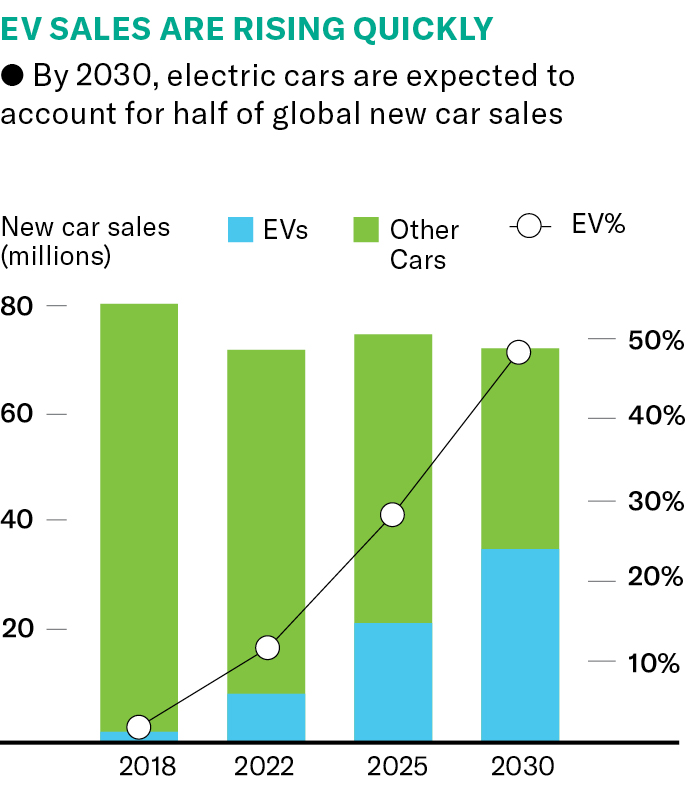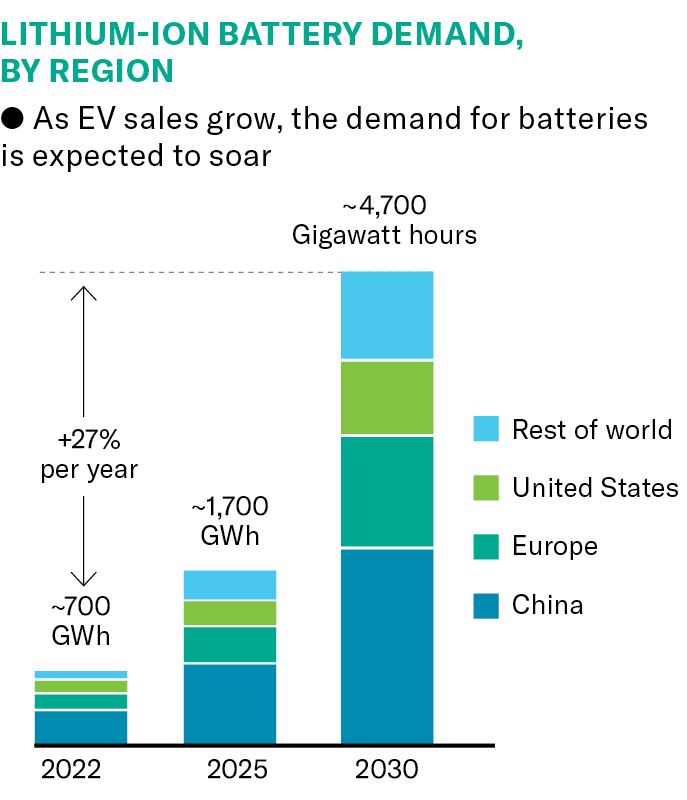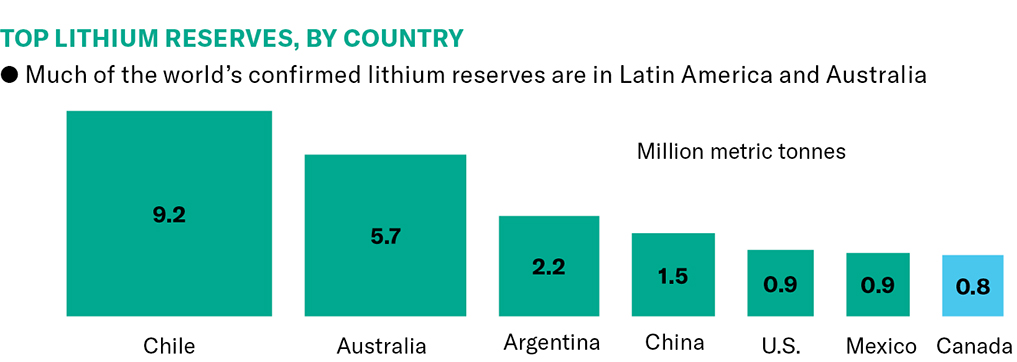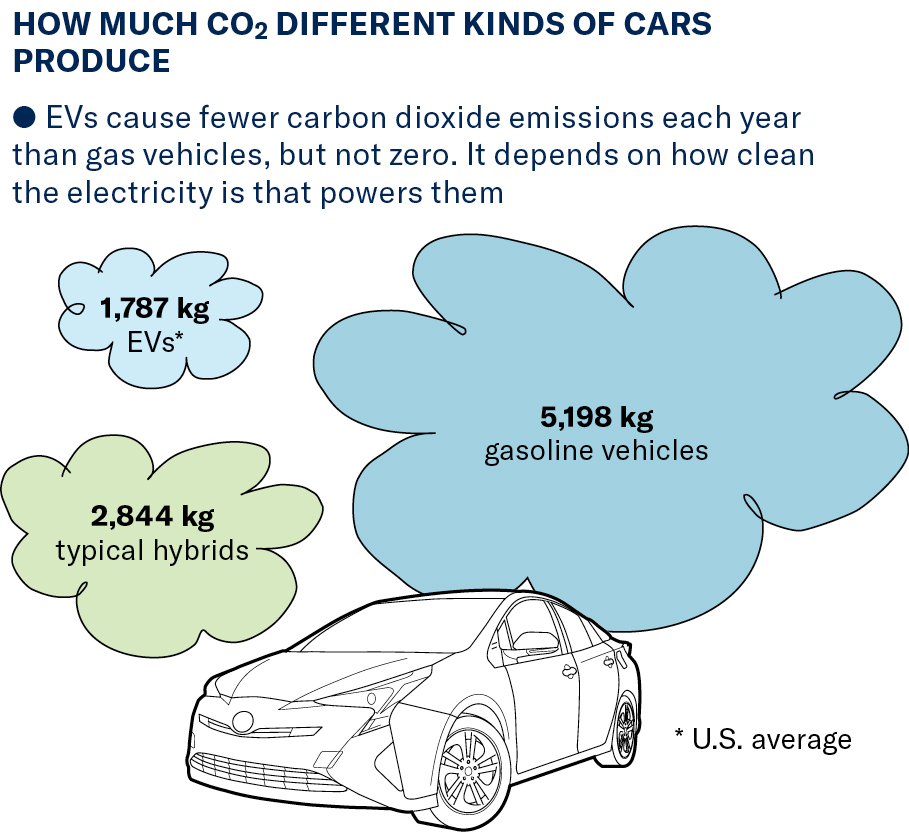Eliminating gas-powered cars and trucks may help avert a climate catastrophe. But they are only part of the solution
As more electric vehicles hum past on city streets, and more charging stations appear on roads and in parking garages, it’s easy to imagine that we are winning the fight against climate change, one electric car at a time.
But electric vehicles by themselves are not a silver bullet to the problem of transportation pollution and climate change. And as we ramp up their use, they will create new problems that will have to be solved, warn U of T researchers who study transportation and climate.
“There is no future without electrification. But just electrification will not get us there,” says Marianne Hatzopoulou, a professor in U of T’s department of civil and mineral engineering. “We don’t want to fall into the trap of thinking that if we support electric vehicles, we’ve solved the problem.”
The transition to electric vehicles is already well on its way. Globally, electric cars made up 14 per cent of new sales in 2022, according to the International Energy Agency. In Canada, all-electric vehicles accounted for seven per cent of new car sales at the beginning of 2023.
At the UN Climate Change Conference in 2022, the Accelerating to Zero Coalition pledged to make all new cars and vans zero-emission by 2035 in leading markets, and by 2040 globally. Canada is currently considering regulations that would require automakers to ensure that 60 per cent of new passenger vehicles available for sale in 2030 are zero-emission, rising to 100 per cent by 2035.

Daniel Posen is an associate professor in U of T’s department of civil and mineral engineering, and the Canada Research Chair in system-scale environmental impacts of energy and transport technologies. He agrees electrification is vital. But relying solely on electric vehicles to reduce carbon emissions from transportation may not be enough, especially if we want to do it in time to stop a catastrophic two-degree rise in global temperatures.
To get an idea of the scale of the problem, Posen, along with Heather MacLean, a professor in U of T’s department of civil and mineral engineering, and postdoctoral researcher Alexandre Milovanoff, looked at how quickly the U.S. would need to electrify transport in order to meet emission goals that would keep warming to less than two degrees.
By 2050, the U.S. would need 90 per cent of all passenger vehicles on the road to be electric – 350 million vehicles. Right now, it has about a million. Considering how long cars last, that would probably mean by 2035 every new car sold would have to be electric.
If the U.S. could get that many EVs on the road that quickly, it would have to increase the electricity it generates by 1,700 terawatt-hours per year – or by about 40 per cent of its total production in 2021.
Posen says that there’s no similar analysis for Canada, but this country will likely face similar challenges in ramping up its electricity production. The problem is especially challenging because, to get the full benefit of EVs, the electricity that powers them – and how they’re manufactured – should be green. If not, you could end up with an EV that creates more greenhouse gases than an efficient gasoline-powered car.
We have to move to a path of decarbonization, but we have to choose that path very soberly”
For example, when you take emissions from manufacturing into account, an EV using electricity in a place like coal-dependent West Virginia will emit about six per cent more greenhouse gases over its entire lifetime than a gas-powered vehicle of the same size, according to Posen’s study.
“Solar and wind have gotten much cheaper than they used to be. These are not prohibitively expensive technologies anymore,” Posen says. “But there will be a challenge in terms of the technical resources, of building up the [green-energy] grid fast enough.”
CRITICAL MINERALS
Possibly one of the most difficult problems electric vehicles will create is the increased demand for critical minerals such as lithium, manganese and cobalt.
To meet the increased demand for green energy technologies, including EVs and the renewable power needed to generate the electricity to build and operate them, production of lithium and cobalt will need to increase by 500 per cent by 2050, according to the World Bank – and that could pose problems. “Mining has a long history of creating significant environmental harms,” says Teresa Kramarz, an assistant professor at U of T’s School of the Environment and co-director of the Environmental Governance Lab. “How are these harms going to be mitigated? Furthermore, how are we going to ensure that the social perils of extractive industries are also avoided?” she asks.
Mining tends to displace people and contaminate local environments. Many critical minerals are found in lower-income countries where, paradoxically, mineral wealth can create huge problems. For instance, in the Democratic Republic of Congo, cobalt mining has contaminated water supplies and cropland, led to a lack of transparency and accountability, and increased forced labour, Kramarz says.
In addition, all the materials that we put in solar panels and batteries will eventually need to be recycled and disposed of properly to avoid contaminating the environment. These include not only the critical minerals, but also heavy metals such as lead, tin and cadmium. “We have to move to a path of decarbonization, but we have to choose that path very soberly, based on what kind of tradeoffs are associated with different options,” says Kramarz.
One promising avenue, developed by Gisele Azimi, a professor of chemical engineering, involves changing the way that the lithium-ion batteries used in electric vehicles are recycled.
Azimi and her team at U of T Engineering’s Laboratory for Strategic Materials, have proposed a new, more sustainable method to extract critical minerals such as lithium, cobalt, nickel and manganese from lithium-ion batteries that have reached the end of their useful lifespan. “These batteries are still very rich in elements of interest,” says Azimi.
Not only can recycling provide these materials at a lower cost, but it also reduces the need to mine raw ore, which comes with all the problems noted by Kramarz. “We really believe in the benefits of this process,” says Azimi.
ELECTRIC VEHICLES BY THE NUMBERS
To meet the soaring demand for electric vehicles, worldwide production of lithium – a silvery metal used in battery manufacturing – will have to increase 500 per cent by 2050, according to the World Bank.



THE AIR WE BREATHE
EVs also promise to reduce ground-level pollution – the kind that affects the air people breathe. Pollutants such as nitrogen oxide and fine particulate matter, which commonly come from cars, cause 15,300 premature deaths in Canada every year – 3,000 of those in the Greater Toronto and Hamilton Area alone, according to Health Canada. In one study, Hatzopoulou found that if all cars and SUVs in the region were electric, there would be 313 fewer deaths every year, with a total social benefit of $2.4 billion.
On the other hand, electric vehicles still create some ground-level pollution in the form of airborne particulates. These come from the grinding of brake pads and rotors, and the wear of tires on roads, says Matthew Adams, an associate professor in the department of geography, geomatics and environment at U of T Mississauga. “EVs are going to eliminate the end-of-tailpipe emissions. Yes, absolutely. But they’re not going to eliminate all emissions,” Adams says.
“It’s really important that people recognize, from a community health perspective, that electric vehicles aren’t going to save us from these particles being generated. How much reduction we will see is still unclear.” It is possible, for example, that the lower operating costs of EVs will encourage people to buy larger vehicles and to drive them more, resulting in even more particulate pollution.
Adams, along with U of T colleagues, is working on a study with the U.S.-based Health Effects Institute to understand EV particulate pollution better.
THE PROBLEM WITH TRUCKS
Converting delivery and long-haul trucks to zero-emission vehicles is an even more difficult problem. Although delivery trucks account for only 15 per cent of traffic by kilometre driven in the Toronto and Hamilton region, they contribute 50 to 70 per cent of the pollutants we breathe, Hatzopoulou says.
Electrification will be especially challenging for long-haul commercial trucks, she says. Partly it’s the larger up-front cost of replacing a commercial fleet. Partly it’s the still-limited range of electric vehicles. And partly it’s the long charging times that could affect scheduling.
Instead of counting on electrification, we might have more immediate impact by redesigning how we deliver goods. “Do you have to have a delivery truck circulating in the neighbourhood?” Hatzopoulou asks.
Distribution centres and routes could be planned so that the “last mile” of deliveries could be made by bicycle, for example. People might also need to stop expecting same- or next-day delivery, which makes it harder for companies to consolidate deliveries. “My thinking is, ‘Yes, technology can get us somewhere.’ But we have to also rethink how we deliver goods in large metropolitan areas,” says Hatzopoulou.
A PATH FORWARD
So, what to do? Every researcher interviewed for this article agreed that electrification is necessary to reduce greenhouse gas emissions. But other steps could be easier, cheaper and just as effective. For example, if you want to make a low-emissions trip today, with a carbon footprint almost as good as the newest electric vehicle, you could simply take the bus.
If you drive a kilometre in an electric car in Ontario today, the emissions from the electricity generated to power that trip come to 15 grams. That’s a lot better than the 250 grams if you drove a gas-powered car. On the other hand, you could do almost as well simply by catching the bus – emissions from public transportation average just under 20 grams per kilometre per person.
“So even your good old diesel bus running up and down Kipling Avenue is still competitive, because of ridership. You’re dividing these emissions from the vehicle by a lot more people,” Hatzopoulou says. A low-emissions bus would bring per-person emissions down even further.
Changing the design of our cities could decrease traffic-related emissions by 25 per cent, according to the Intergovernmental Panel on Climate Change. We could make cities denser, design mixed-use neighbourhoods that people can walk and bike in safely, impose downtown congestion charges, and – this is especially important – improve public transportation, says Steven Farber, an associate professor in the department of human geography at U of T Scarborough. He warns that simply moving to electric cars without making other changes risks “doubling down on a highly inefficient mobility system.”
“There’s still a fundamental problem,” he says. “Car-based mobility systems don’t scale well. In larger cities, they occupy too much space, and therefore they take away land that cities need in order to provide residents with a high quality of life.”
And electric cars don’t solve problems around safety, congestion, land use and travel times.
“Trying to move that many cars around through a city is just completely inefficient,” he says – electric or not.

This story originally published by University of Toronto Magazine. Reposted with permission. Can Electric Vehicles Save the Planet?
